How To Furnish A Dining Room
How To Furnish A Dining Room
By Jack
30th Jun 2025
Learn how to furnish a dining room that feels custom built for cosy breakfasts and show stopping dinner parties, all in a few smart steps.
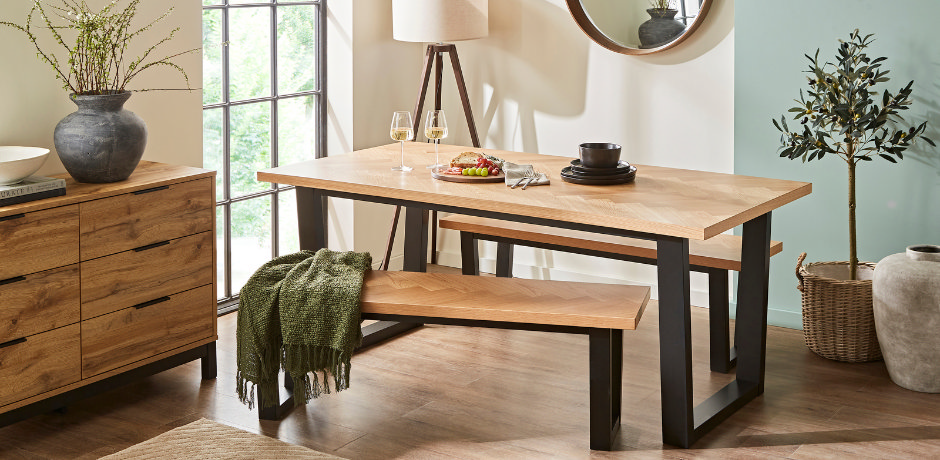
Contents
- Planning Your Dining Room Layout
- Walls & First Impression Finishes
- Dining Room Flooring
- Table Size, Shape & Material
- Sort Your Seating
- Storage & Furniture
- Dining Room Lighting
- Décor, Centrepieces & Styling
- Common Dining Room Mistakes
- Ready to Put It All Together?
A well designed dining room is less about chasing trends and more about orchestrating dozens of small, practical decisions. Decisions like wall finish, flooring, table size, storage, and even sustainability can be broken down step by step.
With fewer than half of Britons (45%) actually sitting at a dining table for dinner and 27% of home workers commandeering the kitchen or dining area as an office, creating a space that tempts everyone back to the table has never been more relevant.
From the wall colour that greets guests at the door to the pendant that pools light over your meals, every choice has a knock on effect on how the space looks, sounds and feels.
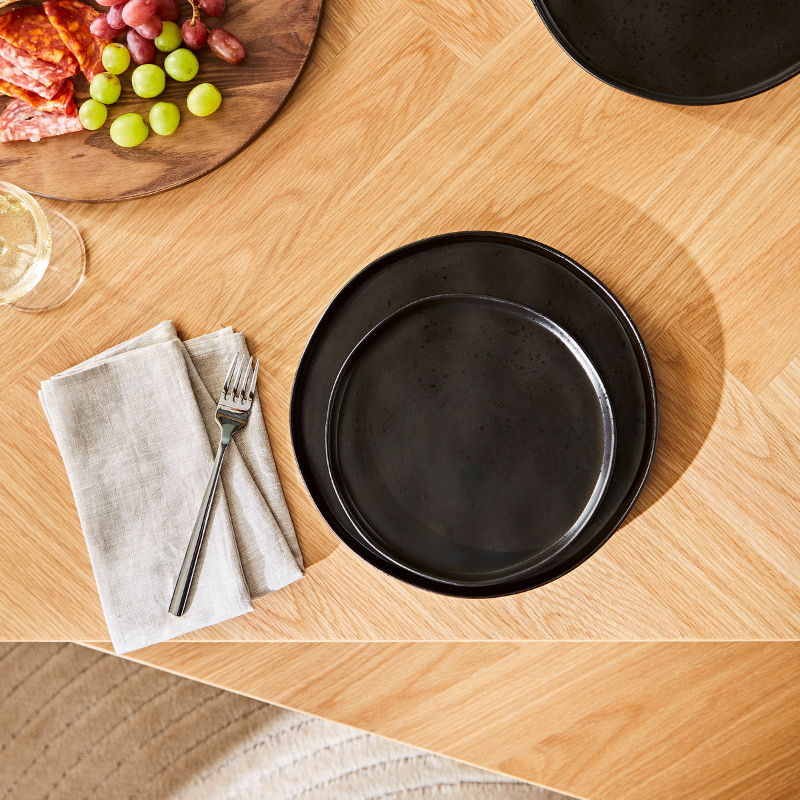
How To Plan Your Dining Room Layout
Allow enough room for guests to walk around your dining room without squeezing past furniture; aim for 45cm+ of walkway width. Unless your table folds down, keep it centred so conversation flows all around during dinner parties. If you have a large dining room, avoid the “floating island” effect, where the table appears to drift in empty floor space, by anchoring the area with a generous rug, a low-hung pendant cluster (a group of pendant lights hung together at varied heights) or even a half-height divider (a pony wall or low shelving that defines the zone without blocking light).
Small dining rooms can benefit from mirrors opposite the window to double daylight, round or drop-leaf tables that soften corners, benches parked against a wall and folding chairs stashed in a cupboard until guests arrive.
Our 7 Step Guide To Furnishing Your Dining Room In Style
Walls And First Impression Finishes
The quickest way to stamp personality on a dining room is to paint the walls. Current UK paint trends for 2025 lean toward earthy terracottas, muted browns, deep greens and a little burnt orange, all of which wrap the space in warmth without feeling faddy. If you crave a more intimate look for your dining room, jewel tones such as navy, charcoal or forest green deliver it in a single coat.
Avoid pairing white walls with dark timber; the harsh contrast can make the space feel more like a clinic than a cosy dining space. Also, try to resist cramming every trend-led colour into one scheme — you’ll tire of it fast.
Wallpaper brings drama where paint alone can’t. A variety of looks and textures all work, but confine a bolder print to one statement wall. For example, behind the table in a small space is perfect, so the pattern has space to breathe. Busier, small-scale repeats crowding every surface can feel dizzying.
Panelling offers a half-height buffer beneath more delicate paper or paint. Whether you favour Shaker boards, tongue-and-groove, slatted battens, fluted ridges or even a faux grid wallpaper that masquerades as timber, the lower panel protects the surface from chair backs. Stick to a low-sheen finish on the wood itself; pairing high-gloss panelling with a glossy floor only creates glare.
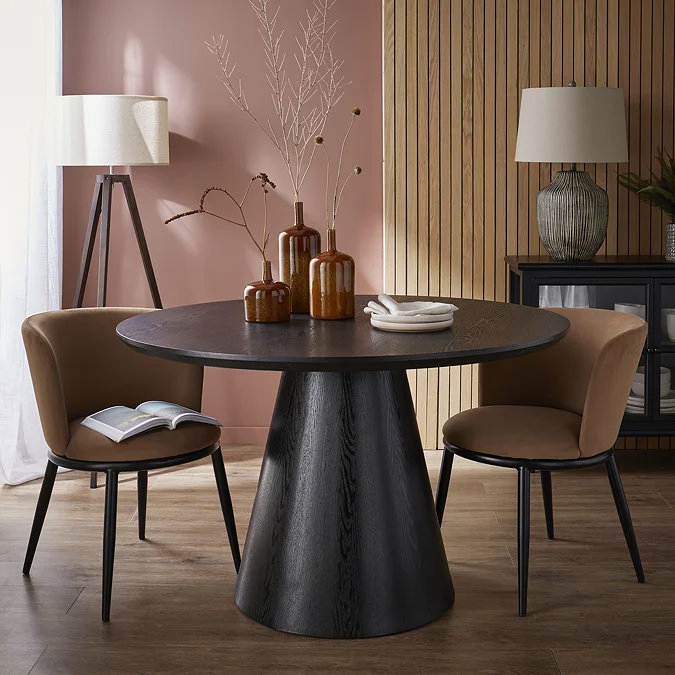
Floors And Rugs
For your dining room floor, trying solid and engineered timber can add comforting warmth and the promise of future refinishing, though softer woods dent easily and always need a moisture proof seal around kitchen diners.
Laminate flooring offers a budget style with click lock ease and scratch resistance, but ultra cheap planks can sound hollow unless you invest in decent underlay. Luxury vinyl tile, whether in faux herringbone oak or encaustic look marble, is fully waterproof and cushioned underfoot, provided you lay it on a perfectly smooth sub-floor.
Porcelain or ceramic tiles are virtually indestructible and flirt happily with under-floor heating, though they demand a rug for warmth and a slip-resistant glaze for safety. Carpet turns a dining room into a cocoon and hushes chair legs, yet it must be a short-pile, stain-guarded weave if you want to avoid a cleaning marathon.
Whatever lies beneath, anchor the table with a rug that extends sixty to seventy centimetres beyond the tabletop on every side so guests can slide chairs without catching an edge. Leave roughly thirty centimetres of bare floor between the rug and the wall to frame the scene.
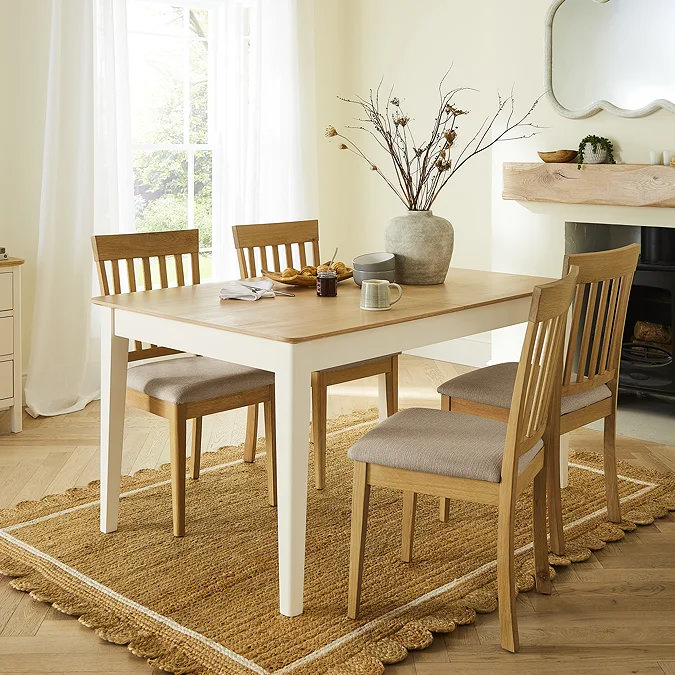
Table Size, Shape and Material
Your dining table should echo the room: square rooms welcome round or square tables, while long rooms balance better with rectangles or ovals. For small homes, consider an extendable, gate-leg or console-to-table design that shrinks when not in service.
Material shapes the dining room mood, too. Solid wood is timeless and can be sanded back after each family chapter; it simply asks for an oil or wax top up. A veneer on MDF grants designer curves at an easier price, so long as you guard against deep scratches that you can’t sand away. Glass lends visual weightlessness and bounces light, but it shows every fingerprint and crumb. Ceramic and porcelain tops mimic marble without the staining drama, although they are heavy enough to demand a sturdy floor. Real stone or concrete is a show stopper yet porous unless sealed, while metal legs, whether industrial black or glamorous brass, free legroom but pick up foot scuffs.
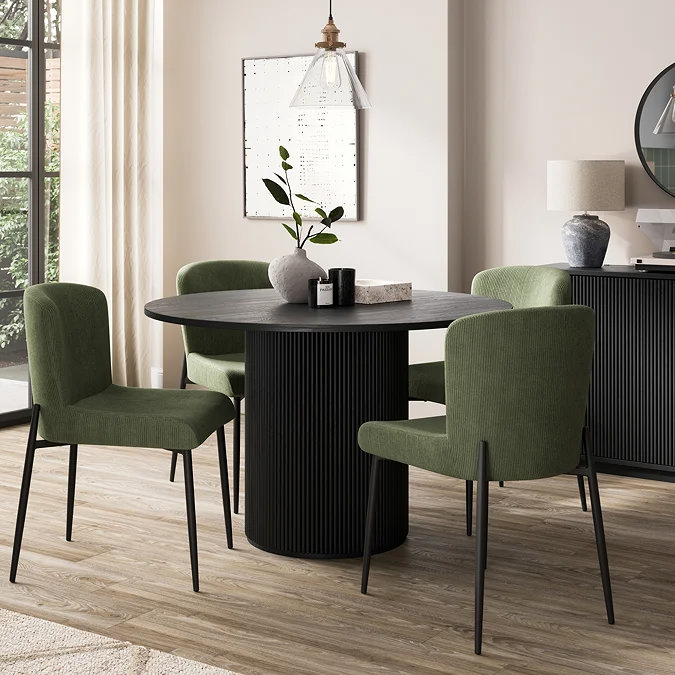
Sort Your Seating
Choose seating that feels relaxed and welcoming first, then check that its shape will glide under your table with ease. Dining chairs that sit a touch lower than your knees create a laid back, ‘linger over dessert’ vibe, while generously proportioned seats give every diner room to settle without jostling elbows. Mix and match seating works when you repeat one element: colour, finish or silhouette, and keep the back heights similar so the arrangement feels intentional.
Benches tuck away neatly and save floor space; add seat pads or a slim backrest if you expect long dinners. For younger diners, junior chairs that sit around 60cm high bridge the gap between high chair and adult seat.
Performance poly-velvets, wipe-down faux leather and stain resistant linens make upholstery worry free. Bear in mind that an Instagram worthy raw farmhouse bench looks welcoming online but tests endurance over a three course meal, so scatter some padded chairs into the mix.

Storage And Multi Task Furniture
A sideboard earns its footprint by hiding table linens and china while its top moonlights as a drinks station. Choose one at least as tall as the dining table. A glass fronted dresser shows off glassware but keeps dust at bay, and built-ins can turn an awkward alcove into a functional display. A bar cart doubles as a dessert trolley after dinner, while a banquette with a lift-up seat gobbles board games, placemats and work-from-home gadgets. If the room still feels bare, a long picture ledge holds art, candles and trailing plants without shrinking floor space.
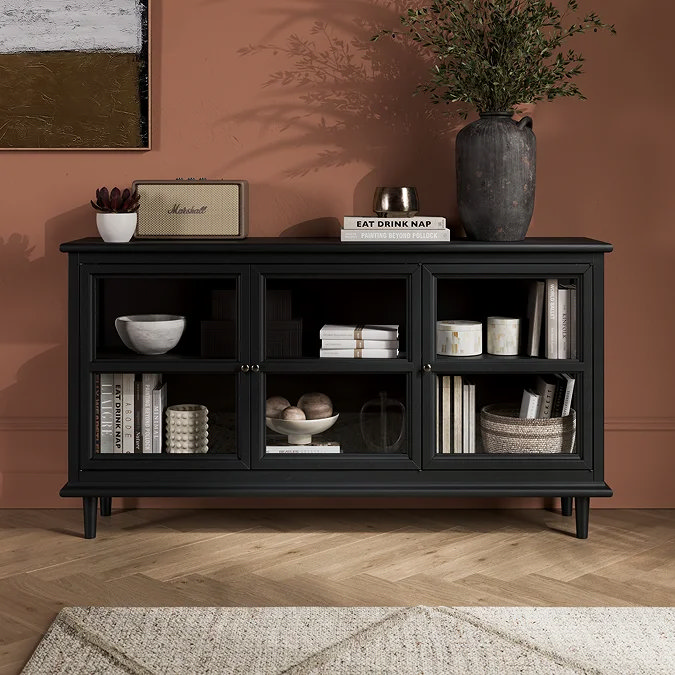
Dining Room Lighting
Think of dining room lighting in layers. Start with ambient light from recessed cans or a semi-flush fitting, but never leave it alone. Overhead glare flattens atmosphere. Over the table, hang a pendant or chandelier that measures roughly half to two-thirds the table width, or simply add the room’s length and width in feet and use the result in inches as your diameter guide.
On very long tables, two smaller fixtures, each roughly a third of the table’s width, feel balanced. Hang the pendants so their bases sit just above seated eye level, casting a flattering glow without blocking conversation, and make sure the shades sit neatly inside the tabletop outline so no one bumps them.
If you prefer multiple pendants in a row, leave enough breathing room between them for separate pools of light rather than one bright strip. Complete the picture with wall sconces placed slightly above standing head height, add a pair of buffet lamps for sparkle, and dot in rechargeable table lamps or candles for a touch of low-level romance.
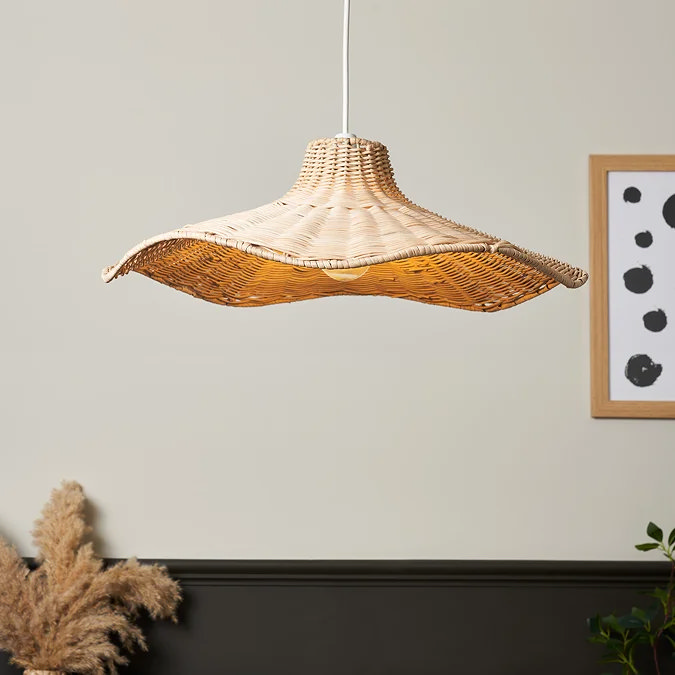
Décor, Centrepieces And Styling
A mirror or artwork two-thirds the length of the table anchors the wall; if you opt for a mirror, go as large as the space permits to double light and, as the feng-shui crowd says, abundance. Keep centrepieces low enough so sightlines stay clear, one sculptural vase or a group of three objects following the rule of thirds works beautifully.
Use a tablecloth only when laying a full formal setting; a simple runner offers softness for daily meals. On the sideboard, a small lamp beside a stack of coffee table books layers texture.
Add height with a faux plant in an oversized vase, then sprinkle trailing additional greenery on shelves for life. Texture makes acoustics cosy, so partner a jute or Persian rug with woven chargers, velvet cushions and linen napkins. Warm creams and olives punctuated by ochre accessories dial up snugness, and natural looking wallpapers bring the outdoors inside.
Common Dining Room Mistakes & How To Avoid Them
- Tape full size outlines on the floor before buying so you avoid oversized or undersized furniture.
- Never rely on a single ceiling fitting; layer a pendant with sconces or lamps to prevent a flat, clinical glow.
- Keep the table away from the wall. Floating it lets every diner sit and move comfortably.
- Glass tabletops magnify fingerprints; if smudges annoy you, choose a textured or tinted surface.
- Instagram ready hard benches grow uncomfortable over long meals; mix in padded chairs for balance.
- Rugs must extend at least 60 cm beyond the tabletop on all sides; avoid thick piles that snag chair legs.
- All hard surfaces create echo so break it up with curtains, cushions and other soft finishes.
- Clear excess decor from the tabletop and store china between uses to keep the space breathable.
- Follow chandelier maths so your fixture sits inside the table edge and is neither too wide nor too narrow.
- Ensure chair arms slide under the apron, layer window dressings to block draughts, soften acoustics with textiles and fit dimmers for instant mood control.
Ready To Furnish Your Dining Room?
Measure twice, tape shapes on the floor and let the dimension guides lead you. Match the table shape to your room proportions, choose chairs that tuck neatly beneath, and begin any styling plan with layered warm lighting, tactile timber, soft fabrics and a splash of greenery.
If the budget is tight, funnel funds into a chandelier you adore and hunt charity or vintage shops for a sideboard with history. Eco-minded? Lean on reclaimed timber, performance weaves and reusable linens.
With this playbook in your back pocket, you’ll know junior chair heights and pendant spacing before a single screw turns. Bookmark it and enjoy designing a dining room that earns applause at every meal.

Jack
Jack is part of the resident home interiors team here at MFI. As a décor and DIY expert, he loves writing in-depth articles and buying guides, and is known for his expert step-by-step tutorials to help you style your home with ease.